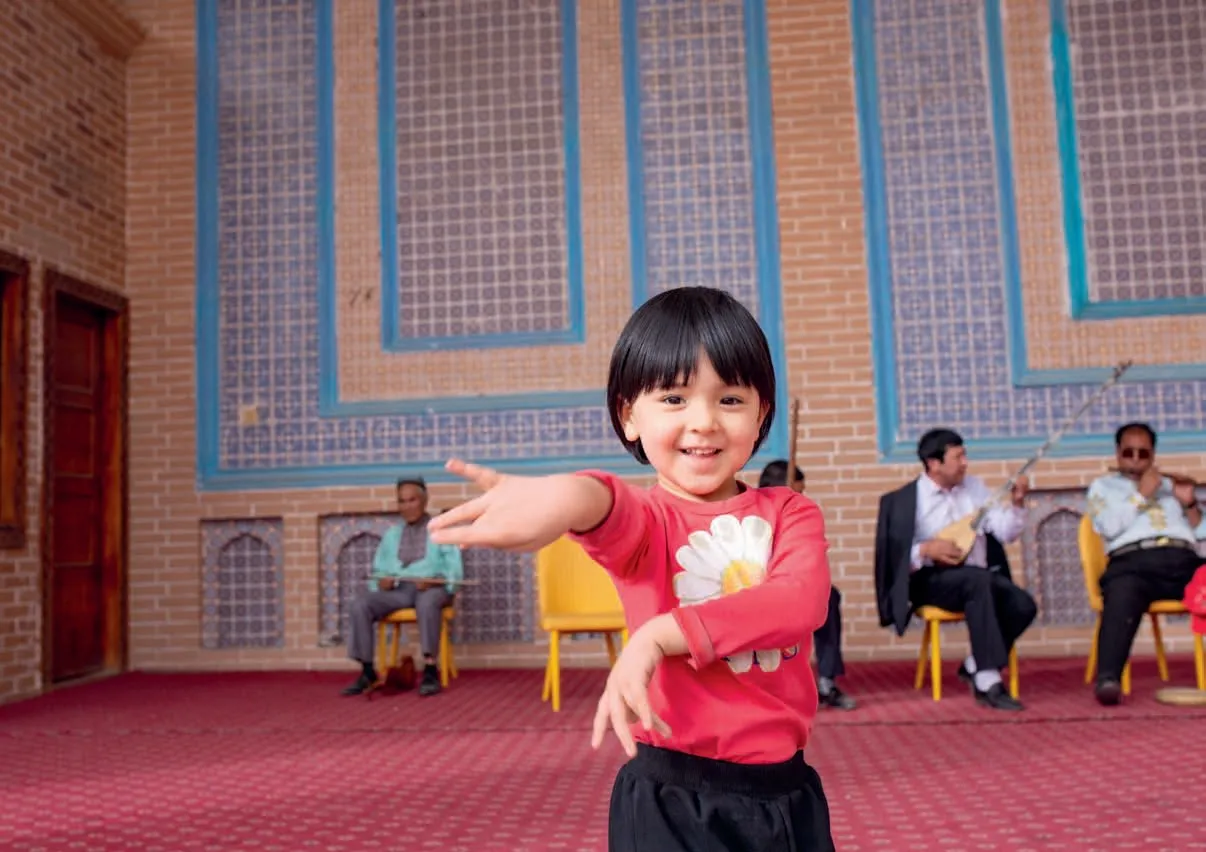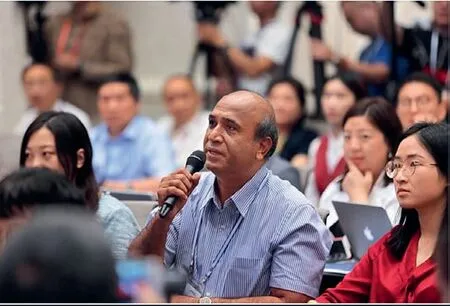Harmony,Stability,and Prosperity in Xinjiang
2022-10-16MUHAMMADASGHAR

Xinjiang people have the final say over their own happiness.
By MUHAMMAD ASGHAR
CHINA’S Xinjiang Uygur Autonomous Region is renowned for its gorgeous natural beauty,diversified ethnic customs, and rich culture.It is the largest provincial region in China covering an area of about 1.66 million square kilometers, roughly the size of Iran. It is home to 25.85 million people, among which the Han ethnic group makes up 10.92 million, and ethnic minorities 14.93 million, according to data from the seventh national census in 2020.
As a reporter with the Associated Press of Pakistan (APP), I have been able to visit several provinces and autonomous regions in China since 2013,and Xinjiang in particular after my appointment as a special correspondent at the APP’s Beijing Office in 2017. During my visits to Xinjiang, I, along with other media workers, witnessed the region’s booming economic growth and infrastructure development, as well as its social and religious stability in major cities such as Urumqi, Kashgar, Hotan, Aksu,and Turpan. People of all ethnic groups in Xinjiang,including Muslims, are living in harmony, enjoying full freedom of religious belief in accordance with the law.
A child is dancing at an intangible cultural heritage park in Kashi, a city in the Tarim Basin region of southern Xinjiang, on October 8, 2021.
peace and harmony
Everywhere l went, l saw people living in peace and harmony,brimming with happiness and vitality.
Prosperity Realized
According to local authorities, Xinjiang Ugyur Autonomous Region registered a seven-percent growth in gross domestic product (GDP) in 2021,totalling nearly RMB 1.6 trillion. A total of 477,400 urban jobs were created throughout the region during the same period, and an upward trend was seen in exports and imports, as well as per capita disposable income of urban and rural residents.
During my several visits to this region, I have some special memories of the friendly local people I met from all walks of life who are working hard to find the value of life and contributing to the development of society. During my last visit in April 2021,I traveled to Kashgar, Aksu, Urumqi, and Turpan by air and land routes and had the opportunity to interact with local people. Everywhere I went, I saw people living in peace and harmony, brimming with happiness and vitality. Over the past decade, cities in that region have undergone huge changes, and the old means of transportation have all been replaced by a modern and robust transportation system which includes airplanes, railways, buses, and cars. Prosperity can be seen everywhere throughout the region.
blatant lies
Based on what l saw, l found that all allegations of“human rights abuses in Xinjiang” were nothing but blatant lies.
A woman is selling dried fruit through live streaming at the Xinjiang International Grand Bazaar in Urumqi,on July 8, 2022.
Religious Freedom Guaranteed
Xinjiang’s social stability and religious freedom are well maintained. There are now more than 24,000 mosques in Xinjiang, representing one mosque for every 530 Muslims on average. On September 26, 2021, a white paper titled “Xinjiang Population Dynamics and Data” was released by the State Council Information Offie of the People’s Republic of China. It reiterated, “Xinjiang protects freedom of religious belief and ensures orderly practice of religion. Believers are free to engage in lawful religious activities, including worship, fasting, and observance of religious festivals, in accordance with religious doctrines, canons, and traditions, at religious venues or in their homes. They face no inference and restriction in this regard.”
According to Abdul Raqib, president of China Islamic Association, also head of Xinjiang Islamic Institute in Urumqi, 10 Islamic institutes have been established across the region to provide training for clergy in mosques aimed at helping them better perform their duties. People can access religious information through various channels including state authorized religious sites, periodicals, and websites.
To improve the conditions of religious venues and the surrounding environment, the regional government has made sure mosques have such facilities as tap water, electricity, heating, air-conditioners, toilets, communication tools, and radios and televisions, as well as libraries and medical services.
I talked to Memet Juma, an imam of the 500-yearold Id Kah Mosque in Kashgar, during my visit in 2021. He told me that no restricitions were imposed on Muslims who wanted to observe fasting during the holy month of Ramadan.
Muslims in Kashgar and across the region are fully free to offer prayers in mosques as normal religious practices are protected by the Constitution of the People’s Republic of China and Xinjiang’s regulations on religious affairs.
However, laws and regulations forbid activities which disrupt public order, harm people’s health or obstruct the national education system under the guise of religion. From 1990 to the end of 2016, separatists, terrorists, and extremist forces launched thousands of terrorist attacks by targeting government organs and planning riots throughout the region resulting in the deaths of ordinary people and the assassinations of religious leaders, endangering public security. After years of endeavors, Xinjiang has seen no violent terrorist attack for over five consecutive years, with infiltration of extremism being effectively contained.
Human Rights Abuses Nothing but Blatant Lies

Back in January of 2019, as a member of a foreign media delegation, I got an opportunity to visit the vocational education and training centers in Kashgar – an oasis city located on the ancient Silk Road linking China with the Western world, and Hotan –a bustling commercial center in southern Xinjiang.Based on what I saw, I found that all allegations of“human rights abuses in Xinjiang” were nothing but blatant lies.
I thought the so-called “camps,” as discredited in some Western media, would be places crowded with large numbers of people and the buildings woud be encircled with barbed wire in horrifying conditions.But to my surprise, there was not a single guard standing at the entry gates, and the centers were more like university campuses having facilities like dormitories, cafeterias, and sports fields.
Inside the centers, Uygur trainees were taking classes to learn stardard Chinese and skills such as catering, house-keeping, sewing, painting, and farming. They were confident, envisioning what they would do to build a better future with their own hands.
We talked to a number of those trainees who were previously influenced by terrorism or religious extremism thoughts. They told us that they took the training program voluntarily and were being well looked after.
I still remember a trainee named Nurkamiljan at the center in Kashgar. Prior to joining the training program, she had only received a primary-school education and had been out of a job. Another female trainee attired in a colorful dress told me that she hoped to find a job with a decent salary after acquiring some useful skills at the center. During her period of studies, she usually traveled home to see her children on the weekends. We were stunned to see some trainees singing and dancing in folk costumes, and were quite impressed with their merry mood. At the cafeteria, healthy and nutritious food was served for their lunch.
Later, we were informed that all trainees at the centers later started their own business or got jobs in Xinjiang or other provinces in China after finishing their training program.
During my last trip to Xinjiang, we also visited a cotton factory in Aksu, one of the country’s major fruit production centers, and the cotton fields near Urumqi, the capital city of Xinjiang, against the backdrop of allegations of “forced labor” in the agriculture sector.

Muhammad Asghar raises a question at a press conference held by the State Council Information Office in 2019.
The local people we interviewed held that the rights of workers there have been well protected under the laws and regulations of China. We did not detect any sign of forced labor. Moreover, the Chinese government has ensured mechanized sowing and harvesting of cotton crops in the region.
Anti-China forces, who intend to suppress the development of the cotton industry in Xinjiang by spreading lies of “forced labor,” have actually deprived local people’s rights to work and development, and also opportunities to enjoy a better life.
All these have proved that the accusation of“genocide” in Xinjiang conjured up by some anti-China forces in the West leads nowhere but violating real human rights. And those people who fabricate and spread lies on Xinjiang affairs are doomed to fail.
Xinjiang people have the fnial say over their own happiness. From years of observation as an outsider,I believe that people of all ethnic groups in Xinjiang understand that today’s prosperity, harmony, and stability in the region did not come easily. Ethnic equality and unity, religious harmony and peacefulness, and socio-economic prosperity are the common goals of all people in Xinjiang.C
MUHAMMAD ASGHAR is a special correspondent at the Associated Press of Pakistan Beijing office.
